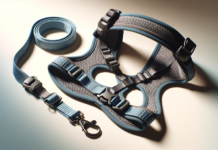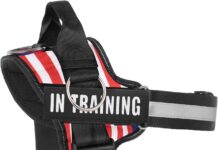There is a heated debate surrounding the use of training collars in dog training. Some argue they are cruel and outdated, while others swear by their effectiveness in training their beloved pets.
But before diving into the training collar controversy, one question consistently arises: is it necessary to consult a professional before using one?
We’ll explore the importance of seeking expert advice when considering a training collar and how it can make all the difference in achieving positive and humane results for our furry friends.
Understanding the Functionality of Training Collars
Training collars can be beneficial tools for teaching our dogs proper behavior and improving their obedience. Several types of training collars are available in the market, each designed with unique features and functionalities. The most common types of training collars include shock, vibration, and spray collars.
Types of training collars
Shock collars, also known as electronic collars, deliver a small electric current to the dog’s neck when activated by the owner. Vibration collars, on the other hand, provide a gentle vibrating sensation to get the dog’s attention. Spray collars release a harmless spray, such as citronella, when the dog engages in unwanted behavior.
How training collars work
Training collars stimulate the dog in response to their actions or behaviors. This stimulus serves as a form of correction to discourage or prevent unwanted behavior. For example, when a dog barks excessively, a training collar can emit a vibration or a slight shock, reminding the dog to stop.
Benefits of using a training collar
Using a training collar can come with several benefits. Firstly, they can help establish clear communication between the owner and the dog. When used properly, a training collar can effectively convey commands and expectations to the dog.
Additionally, training collars can aid in building trust and respect between the owner and the dog. By providing consistent feedback and reinforcement, training collars can help reinforce positive behavior and discourage negative behavior.
Another advantage of training collars is that they offer versatility. Depending on the type of training collar used, owners can easily customize the correction level to suit their dog’s needs. This allows for individualized training that can be effective for a wide range of behavior issues.
The Importance of Proper Training Techniques
Before utilizing a training collar, it is crucial to establish proper training techniques. These techniques ensure the training collar’s effectiveness and create a harmonious relationship between the owner and the dog.
Establishing clear communication with your dog
Practical training relies on clear communication between the owner and the dog. This can be achieved through consistent verbal commands, hand signals, or a combination. By consistently using the same cues, the dog will learn to associate specific actions with commands, making it easier to communicate expectations.
Building trust and respect
Building trust and respect is essential in any dog-owner relationship. By employing positive reinforcement techniques, such as praise, treats, and rewards, owners can create a positive association between desired behaviors and rewards. This fosters a sense of trust and cooperation between the dog and the owner.
Consistency and positive reinforcement
Consistency is vital when it comes to training dogs. Establishing a routine and consistently enforcing rules and expectations helps dogs understand what is expected of them. When the dog exhibits the desired behavior, positive reinforcement, such as treats or praise, also plays a crucial role in practical training.
Potential Risks and Controversies Surrounding Training Collars
While training collars can be practical tools, it is essential to be aware of the potential risks and controversies associated with their use.
Possible physical and psychological harm
Improper use of training collars can potentially cause physical and psychological harm to dogs. Excessive or incorrect use of a shock collar, for example, may cause unnecessary pain or distress to the dog. Using training collars responsibly and following manufacturer guidelines is vital to avoid any harm.
Ethical concerns and alternative training methods
Some individuals have ethical concerns regarding the use of training collars. These concerns mainly revolve around whether using aversive methods, such as shocks or sprays, is humane to train dogs. Alternative training methods are available, such as positive reinforcement training, which focuses on rewarding desired behaviors rather than using punishment.
Understanding individual dog needs
Not all dogs respond the same way to training collars. B breed, temperament, and past experiences can significantly influence a dog’s response to training methods. Understanding and considering these individual needs is crucial when deciding whether to use a training collar.
Exploring the Benefits of Professional Consultation
Consulting a professional before using a training collar can be immensely beneficial. These experts possess the knowledge and experience to address specific behavior issues and provide tailored training solutions.
Expert advice tailored to your dog’s behavior
A professional trainer or behaviorist can assess your dog’s unique behavior patterns and develop a training plan that suits their needs. They deeply understand canine behavior and can provide expert advice on effectively utilizing a training collar as part of a comprehensive and customized training program.
Identifying underlying issues and addressing them effectively
Sometimes, undesirable behaviors exhibited by dogs can stem from underlying issues such as fear, anxiety, or past traumas. A professional can help identify these underlying issues and recommend appropriate training techniques to address them effectively. They can provide insights and strategies beyond using a training collar alone.
Guidance on correct collar usage and techniques
Using a training collar requires proper knowledge and understanding. A professional can guide owners on correctly fitting and adjusting the collar, ensuring it is comfortable and practical for the dog. They can also teach owners various training techniques that work with the collar to maximize its benefits.
Selecting the Right Professional
When seeking professional consultation, it is crucial to find the right individual to meet your needs and ensure the safety and well-being of your dog.
Qualifications and certifications
Look for professionals who have relevant qualifications and certifications in dog training and behavior. Certification programs such as the Certification Council for Professional Dog Trainers (CCPDT) or The International Association of Animal Behavior Consultants (IAABC) provide a reliable measure of a professional’s knowledge and expertise.
Experience and expertise
Consider the experience and expertise of the professional. A well-established trainer or behaviorist who has successfully worked with various dogs and behavior issues is more likely to provide practical guidance and solutions.
Reviews and recommendations
Seek feedback from others who have worked with the professional you are considering. Read reviews and testimonials, and ask for recommendations from trusted sources such as friends, family, or local pet organizations. Positive reviews and recommendations can indicate the professionalism and effectiveness of a trainer.
Gaining Knowledge about Training Collar Usage
Before utilizing a training collar, it is essential to learn about its proper usage to ensure the safety and effectiveness of the training process.
Researching different collar types and their functionalities
Take the time to research the different types of training collars available and understand their functionalities. Each type of collar may have specific guidelines and precautions, so you must familiarize yourself with these details.
Understanding correct fitting and adjustment
Proper fitting and adjustment of a training collar are crucial for its effectiveness and the dog’s comfort. Improperly fitted collars may cause discomfort or injury to the dog. Seek guidance on how to correctly fit and adjust the collar to ensure a secure and appropriate fit.
Learning appropriate training methods
Training collars are most effective when used in conjunction with appropriate training methods. Educate yourself on positive reinforcement techniques and other training approaches that can complement the use of a training collar. By understanding and implementing various techniques, you can create a well-rounded training plan for your dog.
Considering Individual Dog Factors
When deciding whether to use a training collar, it is essential to consider various factors that may affect your dog’s response to training methods.
Breed and temperament considerations
Dog breeds have different temperaments and respond to training methods in various ways. Some breeds may be more sensitive or easily motivated by positive reinforcement, while others may require a firmer approach. Consider your dog’s breed and temperament to determine what training methods and collars may be most effective.
Medical conditions and history
Any pre-existing medical conditions or injuries should be taken into account when deciding whether to use a training collar. Consult with your veterinarian to ensure that the collar will not aggravate or interfere with any existing medical issues. Additionally, consider your dog’s history and any previous negative experiences that may impact their response to training collars.
Personal preferences and limitations
Your personal preferences and limitations should also be considered. Some individuals may feel uncomfortable using aversive training methods, while others may have physical limitations that affect their ability to handle certain types of collars. Finding a training approach that aligns with your values and capabilities is important.
The Role of Consultation in Creating a Safe and Effective Training Plan
Consulting a professional is crucial in creating a safe and effective training plan for your dog when utilizing a training collar.
Determination of training goals
During the consultation, a professional trainer or behaviorist can help clarify your training goals and establish a realistic plan to achieve them. They can assess the specific behaviors you want to address and develop strategies to effectively target and modify them using training collars and other techniques.
Customizing training methods for your dog
Every dog is unique, and what works for one may not work for another. A professional can customize training methods to suit your dog’s personality, learning style, and behavior patterns. By tailoring the training plan, they can optimize the chances of success and ensure that it is safe and effective for your dog.
Avoiding common pitfalls
Training dogs can be challenging, and there are common pitfalls that owners may fall into. A professional can help you navigate these pitfalls and avoid common mistakes. They can provide guidance on timing, consistency, and appropriate levels of correction to prevent any unintended adverse effects of training collars.
Addressing Common Misconceptions about Training Collars
There are several common misconceptions surrounding the use of training collars. Consulting a professional can help clarify these misconceptions and provide accurate information.
Misuse and misunderstanding of training collars
One major misconception is the misuse and misunderstanding of training collars. Some individuals may use them as punishment or rely on excessive correction, leading to potential harm and a negative association with the collar. A professional can guide owners on correctly using training collars, emphasizing the importance of positive reinforcement and other training techniques.
Clarifying misconceptions with professional guidance
Misconceptions about training collars can arise from misinformation or lack of understanding. By consulting a professional, you can gain accurate information and clarification on any doubts or misconceptions. They can provide expert insights based on their experience and knowledge of canine behavior.
Debunking myths about training collars
Several myths are circulating about training collars, ranging from their effectiveness to their potential harm to dogs. A professional can debunk these myths by providing evidence-based information and sharing success stories of dogs who have benefited from the appropriate and responsible use of training collars.
Alternatives to Professional Consultation
While consulting a professional is ideal, alternative resources and methods are available for those who may not have immediate access to professional guidance.
Online resources and training programs
Online resources and training programs can provide valuable information and guidance on using training collars. Websites, videos, and online communities dedicated to dog training can offer tips, techniques, and demonstrations. However, it is essential to carefully vet the source and ensure that the information provided aligns with responsible and ethical training practices.
Group training classes
Group training classes are another alternative to professional consultation. These classes allow for structured training sessions led by experienced trainers. They allow owners and dogs to learn and practice training techniques in a controlled environment. Group classes also foster socialization skills for dogs, making them a beneficial option for specific training needs.
Consulting experienced dog owners.
Experienced dog owners can also provide insights and advice based on their experiences. Seeking guidance from those who have successfully trained their dogs using training collars can be valuable. However, it is essential to remember that each dog is unique, and what works for one may not work for another. Ensure that the advice received aligns with responsible training practices and take individual needs into consideration.
In conclusion, consulting a professional before using a training collar can provide numerous benefits and ensure the safety and effectiveness of the training process. Understanding the functionality of training collars, implementing proper training techniques, considering potential risks, and seeking guidance from qualified professionals are all vital steps in creating a safe and effective training plan for your dog.
By approaching training collars with knowledge, responsibility, and consideration for individual dog factors, we can enhance the training experience and strengthen the bond between dogs and their owners.









































